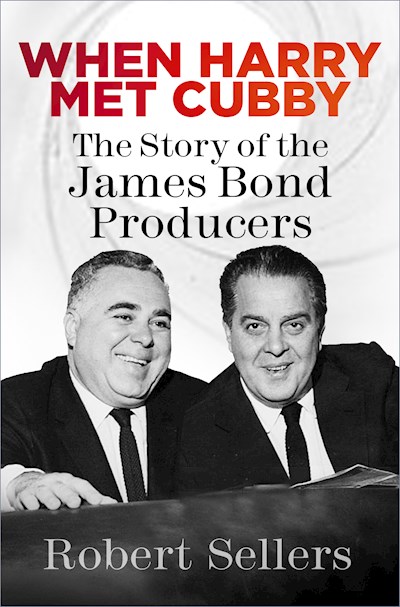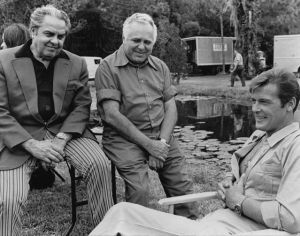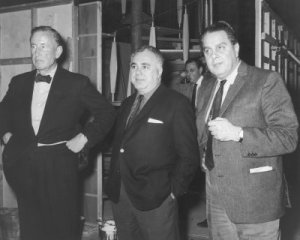Author Robert Sellers provided an in-depth look about the fourth James Bond film, Thunderball, with 2007’s The Battle for Bond. The writer has re-entered the world of Bondage with a new book, When Harry Met Cubby, about the founding 007 film producers, Albert R. Broccoli and Harry Saltzman.
The blog interviewed Sellers about his new book via e-mail.
THE SPY COMMAND: You did a comprehensive book about Thunderball. What about the Broccoli-Saltzman story enticed you to tackle their story?
ROBERT SELLERS: Mainly because no one had done it before, which is strange because seemingly every other aspect of the Bond films has been covered. But not the relationship between these two extraordinary men, not in any great detail that’s for sure. I just thought it was about time their story was told.
SC: The Broccoli-Saltzman partnership was a bit of an Odd Couple affair. What strengths did each partner bring? What was each partner’s weakness?
SELLERS: The words most people used to describe them was chalk and cheese. They shared almost nothing in common, save for drive, ambition and a love of movies. Personality-wise you couldn’t have had two more different individuals. That included their outside pursuits and social circles. If you went to Harry’s house for dinner, or you went to Cubby’s, even if there were 20 people at dinner there was no overlap. Cubby’s friends were completely different to Harry’s.
At the beginning there was this strange alchemy at work, theirs was a relationship that was based on two opposing points of view reaching the same objective and their combined qualities made for an ideal pairing. Things went bad after just a few movies, mainly because Saltzman had so many outside interests. Harry was always buying up companies, signing up talent or movie properties, he had so many other strings to his bow, other balls in the air, whereas Cubby knew that Bond was like the goose that laid the golden egg and was intent on preserving it and to make sure that nobody tarnished it. Broccoli never understood why Harry needed to make other pictures outside Bond and this did lead to friction between the two men.
Both men certainly brought a lot of separate talents to the Bond table. Harry loved the gadgets and gizmos, Cubby was very much concerned with the casting, making sure that the girls were pretty, and worrying about the script, that it didn’t get bogged down with too much dialogue, that it got on with the action, and that the storyline was straightforward enough so people from ten to 100 could follow it.
As (screenwriter) Tom Mankiewicz so brilliantly put it to me: “So much of the pizazz that went in Bond belonged to Harry, and much of the essence and soul of Bond was Cubby.”
SC: Saltzman exited the world of Bond in the mid-1970s. He is perhaps less well known to newer Bond fans compared with Broccoli (especially since Broccoli’s daughter and stepson still run the show). Should Saltzman be better remembered than he is? Why?
SELLERS: Absolutely. People have told me that in the early days Harry was the driving force behind the films, much more proactive than Cubby. That changed later on when Harry began to diversify all over the place. Harry was a real ideas man; he’d churn them out with machine gun rapidity. The only problem was most of his ideas were either too expensive, too impractical or downright dumb. So, it was a case of sieving through the bad ones to get to the good ones. But those good ideas were often absolute gems.
There was also something of the showman about Harry Saltzman, the spit and sawdust of the circuses he worked in during his early days in show business and it was these elements that he later brought to bear upon the Bond movies; everything had to have an over the top style. That was Harry’s circus philosophy, make it bigger, make it more spectacular, make it something audiences have never seen before. There was something of P. T. Barnum about Harry.
SC: Eventually, each partner alternated as primary producer for each Bond film. When did that start? As early as You Only Live Twice? Even earlier?
SELLERS: The fractures in the producer’s relationship was really highlighted around the making of You Only Live Twice, ironically at much the same time as both of them fell out with their star, Sean Connery.
There had always been disagreements behind the scenes, but what had begun to grate with Cubby was the feeling that his partner wasn’t as committed to Bond as he was. This growing imbalance between the two men in their commitment to the Bond pictures reached a point where Cubby just felt aggrieved that he was carrying the load of the franchise almost on his own. As a result, Cubby was pretty much the working producer on You Only Live Twice. I was told Harry never stepped foot in Japan once cameras started rolling.
By the time of Diamonds Are Forever, the two producers could no longer work together and it was decided they ought to take turns being the operating producer on each new Bond. As Guy Hamilton succinctly put it: “I can work very happily with Cubby, and I can work very happily with Harry. But working with Cubby and Harry together is a nightmare.”
SC: Without giving too much away about your book, what was the biggest surprise you encountered during your research?
SELLERS: I guess the thing I could say that impressed me the most was just how much creative control both producers had over the films.
According to Broccoli and Saltzman, there were two kinds of producers, the business and administrative producer and the creative producer. Both men identified themselves as creative producers, involved in all aspects of the filmmaking process, offering ideas and guidance and ultimately putting their individual stamp on the pictures.
In post-production, too, they were a presence in the cutting room and at rushes. Even when the film was in release their job wasn’t finished; they’d scrutinize ad campaigns, carefully go through every detail with the distributors, attend opening nights round the world and read reviews to gauge what the critics were saying.
This was especially important to Broccoli. He might be on holiday or visiting some city in the world, and if there was a Bond film playing, he would go in and sit and listen to the reaction of the audience to find out what they liked, and what they didn’t like.
The way each of them operated as producers on the set was different, though. Harry would be around, but you wouldn’t know he was there. He might be in his trailer or having meetings somewhere. Whereas Cubby was always very visual, always around. And he knew every crew member’s name. The crew loved Cubby, not so much Harry.
SC: In terms of the early Bond films, could any other producers have achieved what they did? Was it like catching lightning in a bottle? I know that a lot of the regular crew members (Ted Moore, Ken Adam, Richard Maibaum) had worked for Broccoli when he was partner with Irving Allen.
SELLERS: I honestly believe the Bond films would not have been the success they were without Broccoli and Saltzman at the helm. Probably their greatest contribution was selecting the right team for the films, many of whom had worked for Cubby before, people that he knew were dependable and could deliver the goods.
On Dr No, Broccoli and Saltzman chose the technicians with the same care and diligence as the actors. They brought together an excellent crew and encouraged them; that was their real talent, hiring the right people and allowing them the creative freedom to express themselves. Can you imagine what the Bond films would have been without the vital contribution of Ken Adam or John Barry? Or for that matter the skillful editing of Peter Hunt, who was brought in by Saltzman.
Broccoli and Saltzman were also risk takers. They knew that in the film business you have to take risks and have the strength of your conviction. Both men were not afraid to make tough decisions and both stood up for what they believed in.
There is no better example of this than their choice of Sean Connery to play Bond. When United Artists voiced their disapproval, Broccoli and Saltzman stood by their man, telling the studio top brass they intended going ahead with Connery or not at all. Instinct told them this was the guy. And history proved them correct, of course. That’s why the Bond films were a success under Harry and Cubby, all the decisions they made were the right ones.
When Harry Met Cubby: The Story of the James Bond Producers is set for publication in September from The History Press. You can view its Amazon entry BY CLICKING HERE. You can view its Amazon UK entry BY CLICKING HERE.
Filed under: James Bond Books, James Bond Films | Tagged: Albert R. Broccoli, Diamonds Are Forever, Dr. No, Harry Saltzman, Robert Sellers, Sean Connery, When Harry Met Cubby, You Only Live Twice |





Leave a comment